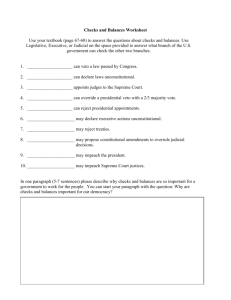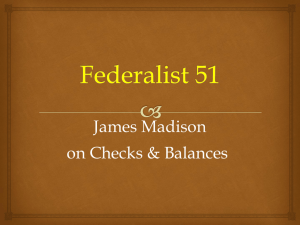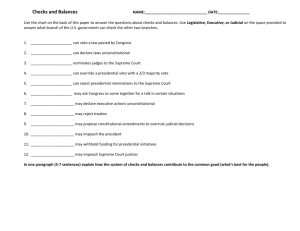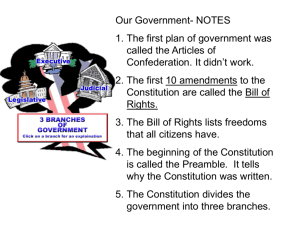File - Ms. Belur's World & US History
advertisement
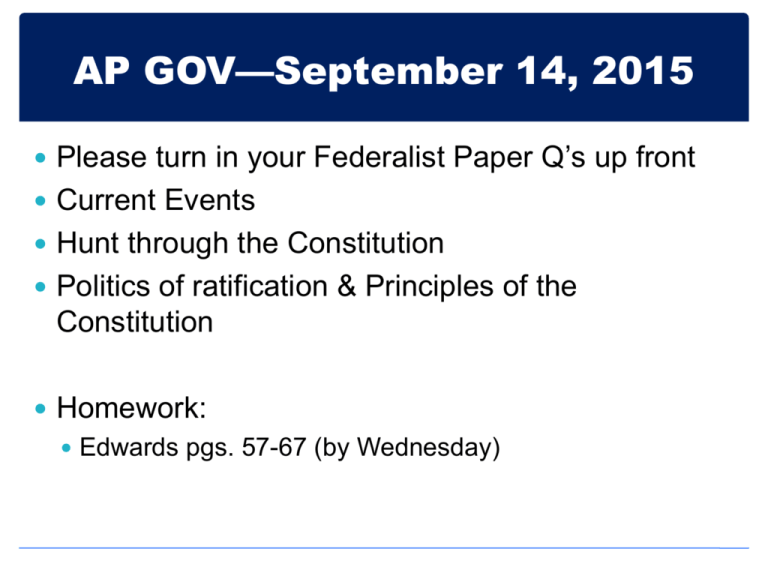
AP GOV—September 14, 2015 Please turn in your Federalist Paper Q’s up front Current Events Hunt through the Constitution Politics of ratification & Principles of the Constitution Homework: Edwards pgs. 57-67 (by Wednesday) The politics of ratification Federalists a. Supporters: property owners, professionals, merchants b. Views: Elites most fit to govern 2. Feared “excesses” of democracy 3. Favored strong central government 1. c. Leaders: Hamilton, Madison, Washington, Jay Antifederalists a. Supporters: small farmers, laborers, shopkeepers b. Views: 1. Feared concentration of power in the hands of elites 2. Believed that gov’t should be closer to the people 3. Feared strong central gov’t 4. Favored stronger state gov’ts 5. Feared the lack of Bill of Rights (strongest argument) c. Leaders: Henry, Mason, Gerry Federalist Advantages a. Were better represented in state legislatures b. Controlled the press c. Began ratification procedures quickly a. Before Anti-feds could get organized d. Agreed to a Bill of Rights after ratification Federalist Papers Madison, Hamilton, and Jay (Publius) Purpose: rally support for Constitution Federalist 10: factions Federalist 51: checks and balances Ratification 1788, took 6 months State ratifying conventions instead of state legislatures Identifying Federalist and Anti-Federalist statements AP Gov—9/15/2015 Warm up: Federalist/Anti-Federalist statements Grab from the back and get started identifying each Principles of the Constitution Democracy in America video (if time) Homework: Edwards pgs. 57-67 (by Wednesday) More info on Debate assignment to come tomorrow! Principles of the Constitution Separation of Powers Checks & Balances Limited Gov’t Judicial Review Separation of Powers A. To Madison, tyranny was gov’t that controlled all 3 branches of gov’t Must divide among legislative, executive, and judicial branches B. System diffuses power instead of concentrating power C. Influence of Montesquieu D. Danger of branches combining forces Lead to checks and balances Checks & Balances A. Background 1. 18th century view of gov’t as something to be restrained, and modern view as something to be used for common good 2. Fear of tyranny among Founders 1. 2. Distrust of gov’t Means of INTENTIONALLY building inefficiency to prevent abuse of power Checks & Balances B. System of restraints in which each branch can check the other two C. Examples Veto Override veto Appointment and confirmation Treaty-making and ratification Commander in chief D. Political independence & staggered terms within each branch Modifications of Checks & Balances 1. Political parties a. In theory, should weaken C&B • Const. divided gov’t, parties bring people in gov’t together b. In reality, political parties are weak • Varied interest, disagreements within parties c. Prevalence of divided gov’t Thus…little change Modifications of Checks & Balances 2. Changes in voting methods/electorate a. Senators now chosen by people b. Congressmen also c. Presidents chosen by electors who vote as the people have voted Thus…members of 2 branches chosen by same electorate (weaken), but split ticket voting has changed this Modifications of Checks & Balances 3. Growth of federal bureaucracy a. Development of numerous agencies b. Congress grants authority to agencies and lets them carry out the will of Congress • Example: IRS Thus…growth of bureau. has weakened C&B Modifications of Checks & Balances 4. Changes in technology (Nuclear weapons, computers, satellite communication, etc.) a. President, Congress, interest groups have all been able to take advantage of new tech. so it strengthens C&B b. President has ESPECIALLY been able to take advantage so it weakens C&B Modifications of Checks & Balances 5. Emergence of the US as a superpower a. Areas of “national interest” extend around the world b. US is leader of the free world c. Any crisis seems to involve US Thus…these issues need to be dealt with in a strong and efficient manner which concentrates power in the executive and weakens C&B Limited Government A. Dilemma of effectiveness versus limited power B. Constitutional gov’t: gov’t only has those powers listed in the constitution C. Bill of Rights as a safeguard against tyranny 10th Amendment gives states all powers not granted to federal gov’t D. Free elections, but potential of majority faction Judicial Review A. Power of courts to strike down laws or gov’t actions B. Not explicitly provided for in Const. but interpretation most logically falls to the courts C. Established by Marbury v. Madison, 1803 Marbury v. Madison Marshall ruled that the Court did not have the authority to issue the writ, but then paradoxically increased power by establishing judicial review Effects: Citizens can challenge constitutionality of laws Litigation as a way to make public policy Exit questions Which branch should have the most power? Do you think the system of checks and balances hurts our political system? Why or why not? What additional checks would you add if any? Which would you remove? Why?
